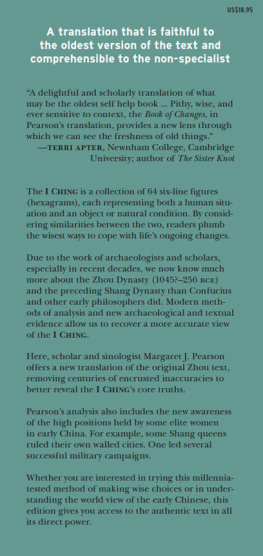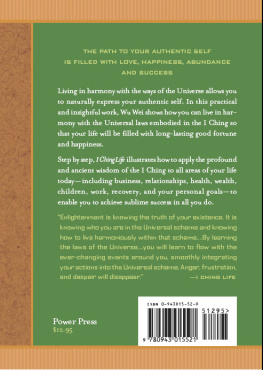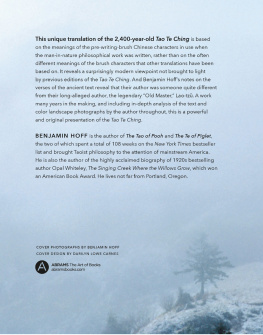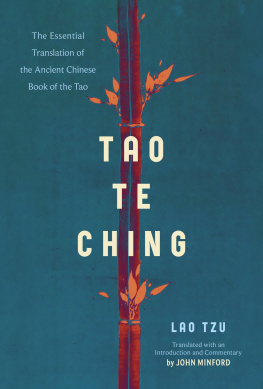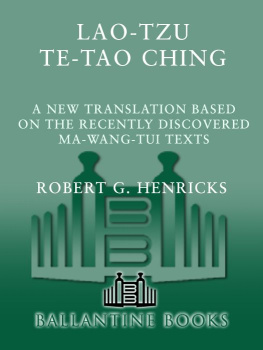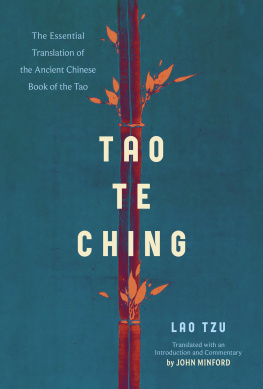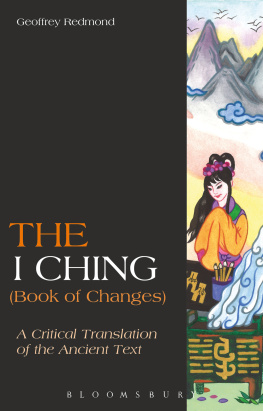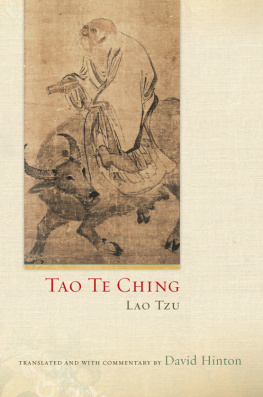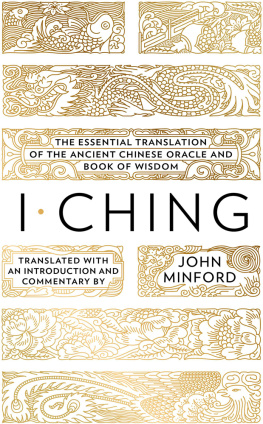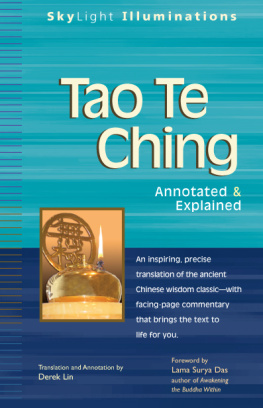Acknowledgments
If you want to see far, it is better to climb a hill than to stand on your toes. Xunzi wrote this, probably not long before China was first unified in 221 BCE, and it remains true today. I could never have attempted this translation without the resources and insights provided by other scholars, most notably Lou Yulie, K.C. Chang, Richard John Lynn, Edward Shaughnessy, and David Keightley.
Several scholarly communities supported this endeavor. Clare Hall, Cambridge University, welcomed me as a Visiting Fellow in 1997, thanks to the sponsorship of Michael Loewe and the support of David Knechtges. Many sections of this work were first presented to the Clare Hall Womens Group, where I received warm support, especially from Asian women scholars. Professor Xinzhong Yao was one of the first to recognize the importance of this difficult task.
My first effort, to translate hexagram 44, was presented at one of the text reading seminars of the Needham Research Institute. I am grateful for the comments I received there, especially from Professors Michael Nylan and Michael Loewe. Mark Lewis, then at Cambridge University, validated my first tentative reinterpretations of key passages. Professor Lynn gave me helpful and encouraging comments on my analysis of hexagram 44, first published in Oracle: the Journal of Yijing Studies (London, 2000). The Needham Research Institute provided office space and intellectual community over several years, while I worked on the life of the great Chinese scientist Zhang Heng. In 2005, I led a discussion of his use of the Changes at another text reading there. In the past few years, membership in the Early China Seminar at Columbia University, capably led by Li Feng and David Branner, enabled me to continue to learn more about the best recent scholarship on early China and its texts.
In preparing the translations, I have relied on the work of many other scholars. My primary Chinese sources include Lou Yuliehs Critical edition of the Works of Wang Bi with explanatory notes ( Wang Bi ji jiaoshi, Beijing, 1980), an inspiring breakthrough in Yijing studies, for he pruned away many commentaries and focused attention on the oldest portions of the text, usually referred to as the Zhou Changes (or Zhouyi ). This edition also helped distinguish between Zhouyi and later versions, and separated Wang Bis contributions from others. I also used Guo Linzongs Paihua Yijing (Taipei, 1999). which was also based on this text. Two Chinese-Chinese dictionaries published in the 1990s were particularly helpful: the Zhouyi Dacidian (Canton, 1993) and Liu Xinlongs Xin pien jiaguwen zidian (Beijing, 1993). The first provided meanings only from Yijing, Shijing, Zuozhuan, and other early works, a very welcome tool for etymological focus. The second provided beautiful images and interpretations of the earliest forms of crucial characters. While some of Lius conclusions may be controversial, given the fragmentary nature of the evidence he used, I consider most of them valid alternatives, and have used them here.
For an understanding of the changing nature of yin , I am particularly grateful for the pioneering work of Vitaly A. Rubin (1982), Alison Black (1989), and Lisa Raphals (1998). Conversations with Professor Nylan at Clare Hall in 2005 encouraged this revisionist approach. I believe that her chapter on yin/yang thought in the revised Cambridge History of China for the Qin and Han eras supports the general direction described by Raphals, Black, and Rubin which I have used as the rationale for this translation. This does not mean, however, that these scholars have reviewed this translation or would agree with every word of it. At the annual meeting of the American Oriental Society in 2010, I presented my arguments on the positive and ungendered meaning of yin . I am grateful for the comments from my listeners there.
Early stages of this twelve-year project received financial support from Skidmore College and the Mellon Foundation. Fongyee Walker provided useful information on terms and images common to both Yijing and Shijing, the subject of her research at Cambridge University. John Moffett generously shared his knowledge of the Zuozhuan and of the many women involved in divination depicted in this late Zhou text. Sally Church helped in many ways, particularly with early drafts on yin . Elizabeth Childs-Johnson, Constance Cook, and Anne Kinney reviewed drafts of the introduction. Jeff Howard reviewed the entire manuscript and helped in many ways, as he did with my dissertation. These scholars have helped me identify mistakes and infelicities. Those that remain are mine alone.
Helmut Wilhelm, Jack Dull, and Hok-lam Chan guided my first steps into sinology as a graduate student at the University of Washington. Carol Thomas led me towards valid cross-cultural comparisons with early Greek history. Her tact and scholarly expertise also enabled me to complete my doctoral dissertation that included the first translation of another early Chinese text into any language. Most recently, the skillful editing of Michael Ochs and the support of my scholarly friend Carol Ochs have been crucial in bringing this task to completion.
I am indebted to the thousands of students I have taught over the last thirty years, and particularly to the hundreds introduced to the Changes in a course I taught every year. The papers they wrote relating what they learned from the Changes to their own lives and dilemmas have taught me much. Particular thanks go to the students who helped me revise the instructions for consulting the book.
I have been fortunate to learn much from many, but I am also quite aware that I have probably made errors, an inescapable reality in the difficult task of reinterpreting a text nearly three thousand years after its creation. While I have tried to emulate the work of my former teacher Burton Watson and of D. C. Lau, their scholarship is greater than mine, as is their command of English precisely suited to accurately conveying Chinese thought. I have dared to undertake this task in large part because I believe that all women who read the Changes deserve at least one translation by a woman scholar with knowledge of Chinese language and history. And, of course, I welcome suggestions for improving the text. As Confucius said, when I am in a group of three, I always have two teachers.
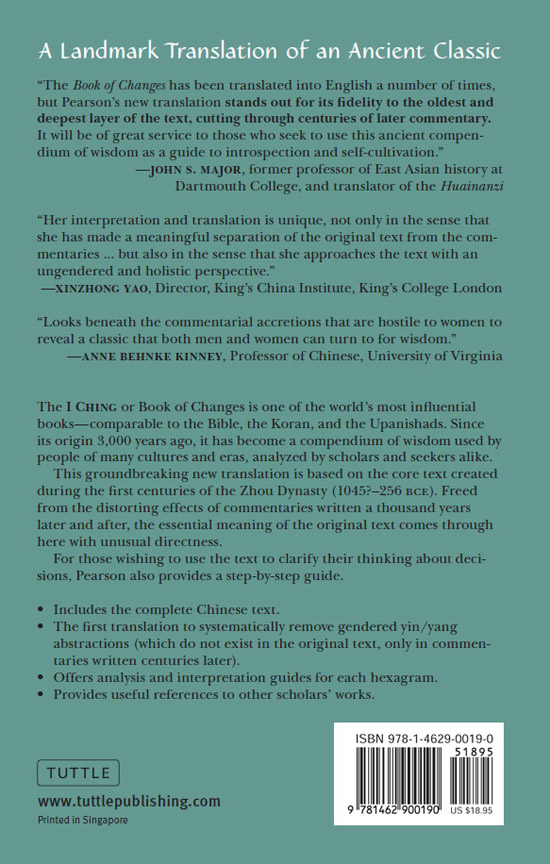
Bibliography
Book of Songs , tr. Bernhard Karlgren (Stockholm: Museum of Far Eastern Antiquities, 1950).
Chung-ying Cheng, Inquiring into the Primary Model: Yi Jing and the Onto-Hermeneutical Tradition, in Journal of Chinese Philosophy 30: 3 & 4 (September/December 2003), 289312.
The Compact Oxford English Dictionary , ed. Murray, Bradley, et al. (New York: Oxford University Press, 1971).
The Cambridge History of Ancient China , ed. Michael Loewe and Edward Shaughnessy (Cambridge: Cambridge University Press, 1998).
Guo Moruo, ed., Jiaguwen heji (Beijing: Zhunghua, 19791982).
Bernhard Karlgren, Grammatica Serica Recensa , reprint from Museum of Far Eastern Antiquities , Bulletin No. 29 (Stockholm, 1957).
David Keightley, The Oracle-Bone Inscriptions of the Late Shang Dynasty, in Sources of Chinese Tradition (second edition) , vol. I, compiled by William Theodore deBary and Irene Bloom (New York: Columbia University Press, 1999), 320.
Kong Yingda, Zhouyi zhengyi , 5: 4a4b.
Liu Xing-lung, ed., Xin pien jiagu wen zidian (Beijing: International Culture Publishing Company, 1993).
Richard John Lynn, The Classic of Changes: A New Translation of the I Ching as Interpreted by Wang Bi (New York: Columbia University Press, 1994).

